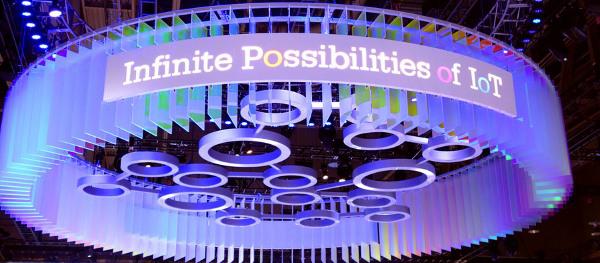Sorry, I just can't stand the term. How lame! It's not freakin' magic and infinite possibilities have always been "available".
The Internet of Things Is Upon Us

The so-called Internet of Things (IoT) (or the slightly less awkwardly phrased “Internet of Everything”) was an undeniable trend at 2015 CES, with practically everything being connected in some manner. In the Central Hall, a large pillar in Qualcomm’s booth asked, “When will anything, anywhere be connected?” and “When will everything speak to the next thing?” It would appear the answer to both is, “Soon!” The IoT took front and center stage during Samsung’s opening keynote speech where company president and CEO, Boo-Keun Yoon, voiced his company’s commitment to connected devices, announcing plans on investing more than $100 million in its developer program this year alone. Yoon went on to say that 90 percent of Samsung’s products will be connected by 2017 with 100 percent of Samsung’s products being IoT-capable in five years.
Nowhere was the IoT more present than at Eureka Park, a section of CES dedicated to smaller companies displaying up-and-coming technologies. In fact, you practically couldn’t take two steps in any direction without running into some new take on a “smart,” connected product, many using technology to address old issues in new and innovative ways.
Some IoT devices that caught my attention included a toothbrush that tracks your kid’s brushing times and uses games to encourage longer and better brushing; a device that floats in your swimming pool to track water temperature and chemical levels and suggests what to add to properly balance the water; irrigation systems that monitor local weather patterns to avoid over- or underwatering; home brewing kits that monitor the cooking times and temps and hop additions of your current batch as well as suggesting new recipes; a smart and safe outlet that only passes current when an electrical device is plugged in and not, say, a knife or toddler’s finger; a smart battery that enables any smoke detector to report trouble or when a battery is getting low; a high-tech rifle that lets other hunters or military operators remotely view through the scope; various sensors, detectors, and monitors that alert you to water leaks, carbon monoxide, smoke, motion, and temperature changes; wearables that monitor your exercise and sleep patterns and even let you know when you’ve had too much to drink.
Having hundreds of smart devices is all well and good, but for the IoT to truly succeed and be beneficial, these individual devices will need to work together and not be technological islands unto themselves. Having to open numerous different apps on a smartphone to lock your doors, turn off the lights, adjust the temperature, turn off the entertainment system, and arm the security system is far less convenient than a single Away button that does it all for you. Or just walking away from the house and having it automatically perform these functions.
While various automation systems like Control4, Crestron, Elan, and Savant can do these sorts of things today, the proliferation of devices from a huge variety of manufacturers will require some kind of unified communication for the IoT to truly succeed. Perhaps this will be one of the features of Apple’s forthcoming HomeKit. When I described the IoT trend to my dad, his immediate response was, “Why in the world would I want my refrigerator talking to my washing machine?”
And, the truth is, you probably wouldn’t. But what if your home and personal devices were sentient enough to always know what was happening in your life and smart enough to help you? What if, when you pulled a pizza out of the freezer, it set a reminder for the next time you went shopping to buy another pizza, alerted the oven to preheat to the right temperature, and told the HVAC system to drop the temp a couple of degrees while the oven was on? What if your home could know when you were coming home and automatically prepare the house for your arrival? These are the dreams of the truly IoT lifestyle. And it’s not nearly that far off.
- Log in or register to post comments






































































